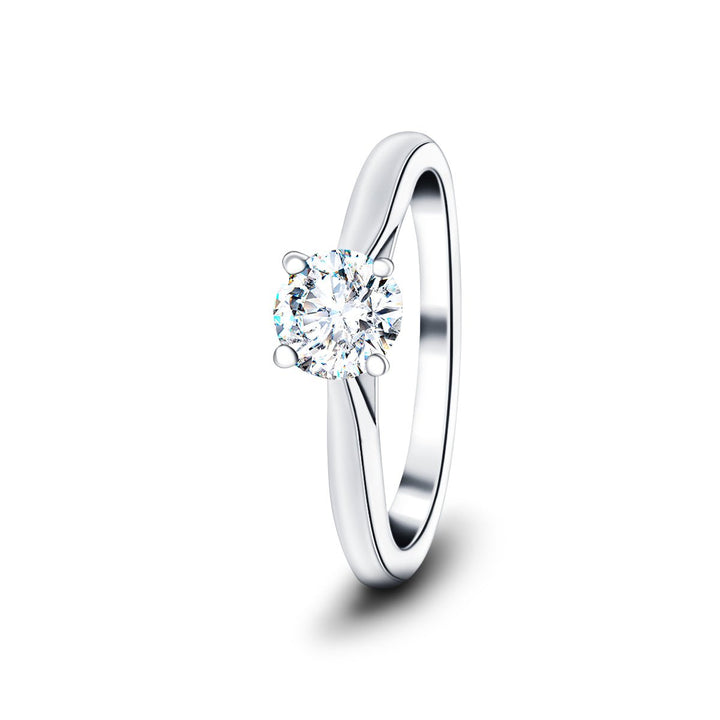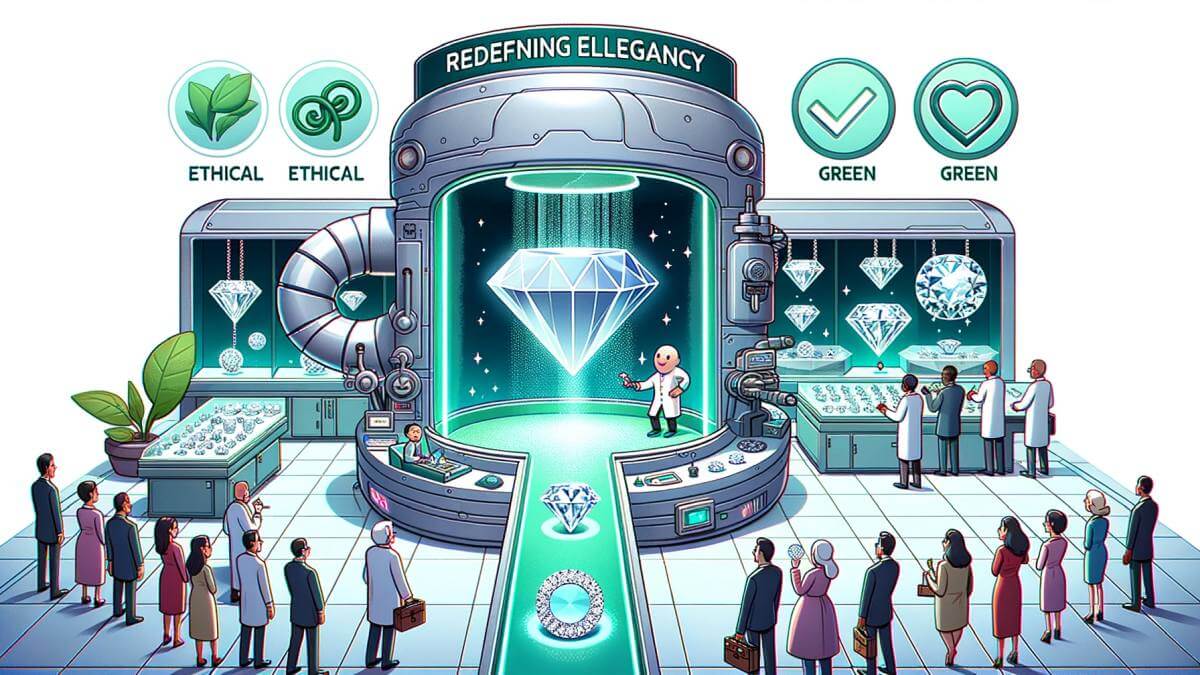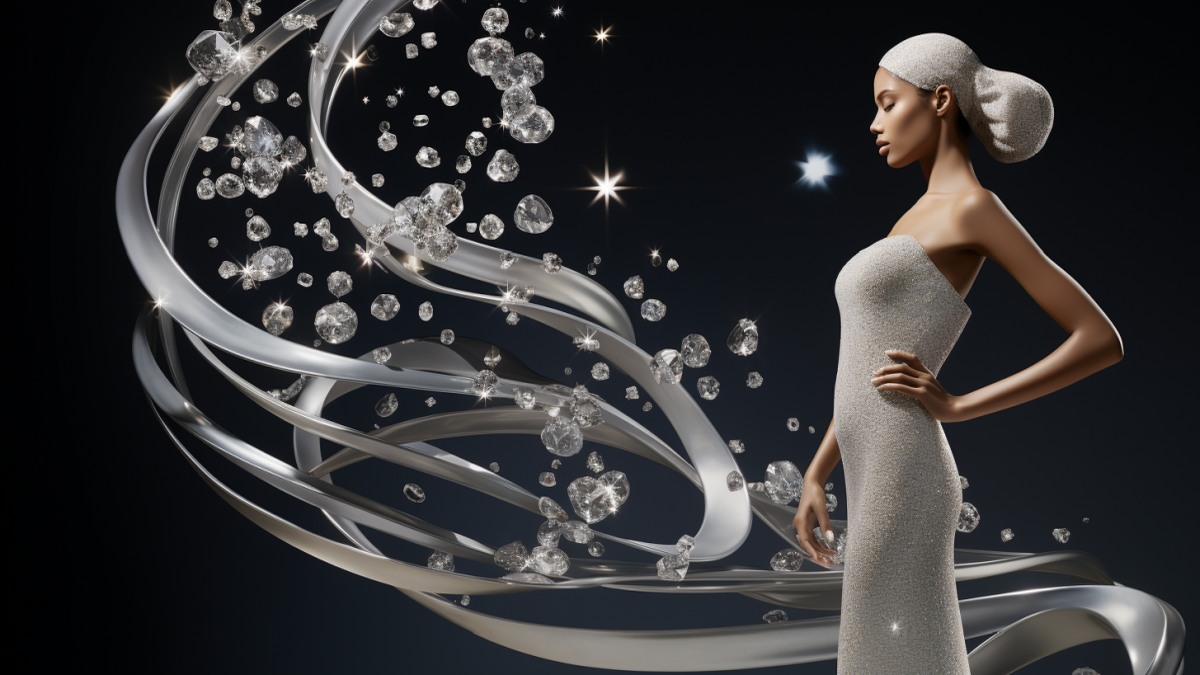This article will unravel the mysteries behind these captivating gemstones by looking at the 4 Cs of diamonds.
Like a symphony of size, carat weight sets the stage. At the same time, the artistry of the jeweller's cut is the canvas that creates brilliance and sparkle.
Painting with light, colour grading reveals a spectrum of hues.
Lastly, clarity is a window to purity, showcasing the flawless beauty within the diamond.
Join us on this enlightening journey as we delve into the world of diamonds, offering valuable insights for those seeking belonging in this captivating realm.
The Essence of the 4 Cs of Diamonds
When it comes to diamonds, understanding the 4 Cs - carat weight, colour, clarity, and cut - is essential for determining their quality and value. Each C plays a crucial role in determining a diamond's overall beauty and desirability.
From the size and weight to the brilliance and sparkle, the 4 Cs provide a comprehensive framework for evaluating diamonds and making informed purchasing decisions.
Quality and Value
The essence of the 4 Cs is at the heart of our understanding of the quality and value of a diamond.
When it comes to diamond pricing, several factors come into play. One of the key factors is the grading standards set by reputable organisations such as the Gemological Institute of America (GIA). To determine its quality, these standards evaluate a diamond's cut, colour, clarity, and carat weight.
The cut refers to how well a diamond is proportioned and shaped, which affects its brilliance and sparkle. The colour grading assesses the presence of any tint or hue in a diamond, with the most valuable diamonds being colourless. Clarity grading examines the existence of any internal or external flaws which can impact a diamond's value. Lastly, carat weight measures the size of a diamond.
All these factors, along with market demand, rarity, and supply, contribute to the value of a diamond.
Understanding these factors will empower you to make an informed decision when purchasing a diamond and ensure you get the best quality and value for your investment.
Ella Lab Diamond Solitaire Engagement Ring 1.00ct G/VS 18k White Gold

£910.00
£1,736.00
Unveil the radiance of love with the Ella Lab Diamond Solitaire Engagement Ring, crafted in the UK with the finest materials. This ring features a stunning 1.00-carat G/VS-graded lab-grown diamond set in 18k white gold, creating a captivating brilliance. The… read more
Diamond Carat Weight: A Symphony of Size
Regarding diamonds, the carat weight is a significant factor to consider. The carat weight refers to the size of the diamond and is often associated with its value. But did you know that the term 'carat' comes from the ancient carob seeds used to weigh precious gemstones? These seeds were known for their uniform weight, making them a reliable measurement standard. Nowadays, one carat is the same as 0.20g, or 1g equals 5 carats. Even relatively large diamonds weigh very little!
However, it's important to note that carat weight alone does not determine the visual size of a diamond. The differing proportions of different diamond shapes can create an illusion of a larger or smaller appearance, even when the carat weight is the same. For instance, a well-cut diamond with a round shape tends to have a smaller face-up appearance than a diamond with a fancy shape, such as an oval or marquise. The round shape has more depth, resulting in the carat weight being distributed differently.
Diamond Size is More Than Just Weight!
Suppose you want a visually impressive diamond in your jewellery. In that case, choosing a princess, cushion, or oval diamond might be best. One disadvantage of choosing a fancy-cut diamond over a round one is that the depth of the diamond, when looked at from above, affects the brilliance and sparkle of the stone. A round diamond will tend to have a better visual display than a fancy shape. However, when cut well, the differences are not great!
As a novice buyer, it is crucial to understand that carat weight is not the sole determining factor of a diamond's quality. While a higher carat weight may initially seem appealing, it's essential to remember that a diamond's cut, colour, and clarity also play a crucial role in its overall beauty and value.
While carat weight is undoubtedly an important consideration, it's crucial to remember that diamonds are a symphony of size, cut, colour, and clarity. By understanding and appreciating these factors, you can make an informed decision and find the perfect diamond that shines bright and holds sentimental value for a lifetime.
Lab Diamond Solitaire Stud Bezel Set Earrings 2.00ct G/VS 18k Yellow Gold

£1,390.00
£2,651.00
The Lab Diamond Solitaire Stud Bezel Set Earrings feature a beautiful 2.00 carats total weight of G/VS-graded lab-grown diamonds, set in 18k yellow gold with a sleek and modern bezel setting. These earrings are perfect for any occasion, adding a… read more
Diamond Cut Quality: The Artist's Canvas
The cut of a diamond is often referred to as the artist's canvas, as it plays a crucial role in enhancing the diamond's beauty and brilliance.
In the context of diamond quality, 'cut' refers to the quality of the creation of the facets of the diamond, how well it is polished and how well the diamond cutter has been able to create good symmetry and proportions in the finished diamond.
This can confuse many newcomers to diamond jewellery as it is widespread for different shapes of diamond to be referred to as 'cuts'.
The quality of the cut is, in many experts' opinion, the most important element of the 4Cs because this is the only aspect of the finished diamond's appearance that is under the control of the artisans who create the facets and polished surfaces that reflect and diffract light, giving the diamond its sparkle and brilliance. A poorly cut diamond will have less brilliance and sparkle than a well-cut stone.
Tips for Selecting the Best Cut
One important tip for selecting the proper cut of a diamond is to consider the proportion and symmetry of the diamond's facets. The cut of a diamond refers to how well it has been shaped and faceted. It is a crucial factor that determines the diamond's brilliance and sparkle.
When selecting the perfect cut, a few cut quality considerations must be remembered. First, look for a diamond with excellent symmetry, meaning all facets are aligned correctly.
Second, consider the proportion of the diamond, including the table (the flat area of the diamond visible when looking at the top of the stone) and depth percentages. These proportions can significantly impact the diamond's ability to reflect light.
Lastly, pay attention to the overall cut grade, which is determined by a combination of these factors. By considering these diamond cut tips, you can ensure that you select a diamond with a beautiful and brilliant cut.
The Cut grades for diamonds range from Excellent to Poor and are assessed based on brightness, fire, scintillation, and overall visual appeal. An Excellent cut grade indicates maximum brilliance and sparkle. In contrast, a Poor cut grade signifies a lacklustre appearance and inferior light performance.
Colour: Painting with Light
Regarding diamonds, colour is crucial in determining their value and beauty. The colour of a diamond is a result of impurities and structural defects within the crystal.
In this discussion, we will explore the various factors that affect the colour of diamonds and understand how they can enhance or detract from their overall appeal.
Diamond Colour Grade Scales in the 4Cs
The diamond colour grading scale used by the GIA (Gemological Institute of America) and most diamond jewellery retailers ranges from D to Z. D represents the highest and most colourless grade. At the same time, Z indicates a diamond with a noticeable yellow or brown colour. In between, the scale grades diamonds in the increasing presence of colour, with G, H, and I being near-colourless grades and J, K, and beyond having visible colour.
The colour grading is done under controlled lighting conditions. It compares the diamond against a master set of diamonds with known colours. The most advanced grading labs now use high-tech equipment to directly measure and classify the colour without human intervention.
Advice for Consideration About Diamond Colour
Reflecting the importance of colour in diamonds understanding how light interacts with the gemstone is essential for appreciating its true beauty. Here is some advice for consideration when exploring the world of diamond colour:
- Don't pay for something you cannot see! Suppose you cannot see the difference between a an E colour grade diamond and a G colour grade diamond under good lighting. In that case, it may be wise to save a little money or to use the same budget to buy a larger G-graded stone instead!
- Evaluate options: Consider your personal preferences and the style of jewellery you are looking for. Some individuals may prefer a colourless diamond for its classic appeal. In contrast, others may be drawn to the warmth of a slightly tinted diamond.
- View diamonds in different lighting: Examine diamonds in various lighting conditions to observe how the colour appears. Natural daylight and LED lighting often provide the most accurate representation of a diamond's colour.
- Seek professional guidance: Consult with a reputable jeweller or gemologist who can provide expert advice on diamond colour and help you make an informed decision.
- Trust your instincts: Choose a diamond colour that resonates with you and brings you joy. Remember, the beauty of a diamond lies in the eyes of the beholder.
Clarity: A Window to Purity
When it comes to evaluating the quality of a diamond, clarity is a crucial factor to consider.
Clarity refers to the presence of any internal or external flaws, known as inclusions and blemishes, respectively. These imperfections can affect the overall beauty and brilliance of the diamond and its value.
In this section, we will explore the different clarity grades and how they impact the appearance and value of a diamond.
Lab Diamond Solitaire Necklace Pendant 2.00ct G/VS in 18k White Gold

£1,870.00
£3,566.00
Elevate your style with the captivating Lab Diamond Solitaire Necklace Pendant, a handcrafted masterpiece designed to last a lifetime. The pendant features a dazzling 2.00-carat G/VS lab-grown diamond in a classic claw setting in a luxurious 18k white gold setting.… read more
Suggestions About Diamond Clarity for Newcomers to Diamond Jewellery
To better understand diamond clarity, novices should focus on examining the diamond's internal characteristics and external blemishes, as they provide valuable insights into the stone's purity. Here are some suggestions for novices to consider when evaluating diamond quality:
- Familiarise yourself with diamond grading: Learn about the different clarity grades, such as Flawless, VVS1, VS2, and SI1, and understand how they relate to the presence of inclusions and blemishes within the diamond.
- Use a loupe or magnifying glass: Take the time to closely inspect the diamond under magnification to identify any imperfections that may affect its clarity.
- Consider the location and size of the inclusions: Inclusions closer to the centre of the diamond may affect its brilliance, while more prominent inclusions may be more easily visible to the naked eye.
- Understand the impact of clarity on the overall appearance: Remember that higher clarity grades usually result in diamonds with better light reflection and sparkle.
- Seek expert advice: Don't hesitate to consult a reputable jeweller or gemologist who can guide you and help you make an informed decision.
Lab-Grown Diamonds: The New Kids on the Block
The lab-grown diamonds, also known as synthetic diamonds, have emerged as a new and intriguing addition to the world of diamonds. These diamonds are created in a laboratory using advanced technology, replicating the conditions under which natural diamonds are formed.
One of the advantages of lab-grown diamonds is their cost. They are typically more affordable than natural diamonds of the same size and quality. This makes them an excellent option for those looking for a beautiful diamond without breaking the bank.
Another advantage is the environmental impact. Lab-grown diamonds are created in a controlled environment, which means there is no need for mining. This eliminates the adverse ecological effects often associated with diamond mining, such as deforestation, displacement of wildlife, and water pollution.
When it comes to the comparison between lab-grown and natural diamonds, there are a few key differences to consider. While lab-grown diamonds have the same physical and chemical properties as natural diamonds, they are not as rare. Natural diamonds are formed over millions of years, making them more valuable and sought after. However, lab-grown diamonds offer a more sustainable and affordable alternative for those prioritising these factors.
Lab Diamond Solitaire Stud Earrings 1.40ct G/VS in 18k Yellow Gold

£1,035.00
£1,976.00
Add a touch of glamour to your look with the Lab Diamond Solitaire Stud Earrings, featuring 1.40 carats of G/VS-graded lab-grown diamonds set in 18k yellow gold. These round solitaire diamond earrings are designed and handcrafted in the UK, with… read more
Making Enlightened Choices and the 4 Cs of Diamonds
One key aspect of making enlightened choices when purchasing a diamond is understanding the importance of the 4 Cs: carat weight, cut, colour, and clarity. Each of these factors plays a significant role in determining the value and beauty of a diamond.
However, in addition to considering the 4 Cs, it is also essential to consider ethical sourcing, diamond grading, and sustainable practices.
To make an informed decision, here are some key points to keep in mind:
- Ethical Sourcing: Look for responsibly sourced diamonds with production that adheres to ethical practices. This ensures the diamonds are not associated with conflict or human rights abuses.
- Diamond Grading: Familiarise yourself with the different diamond grading systems, such as the GIA (Gemological Institute of America) grading system. This will help you understand the quality and characteristics of the diamond you are considering.
- Sustainable Practices: Consider diamonds sourced and produced using sustainable practices. This includes minimising environmental impact and supporting initiatives that promote responsible mining and manufacturing processes.
- Certification: Look for diamonds with a reputable certification, such as GIA, IGI or AGS. These certifications provide assurance of the diamond's quality and authenticity.
- Ask Questions: Don't hesitate to ask the jeweller or seller about the diamond's origin, certification, and other relevant information. A reputable seller will be transparent and happy to provide the necessary information.
Final Reflections and Making The Best Diamond Jewellery Choices
After considering the importance of the 4 Cs and the various factors involved in making an informed diamond purchase, it is evident that final reflections should encompass the overall value and significance of the chosen diamond. Final thoughts allow buyers to truly understand the clarity, symbolism, and personal meaning of the diamond they have chosen.
When reflecting on the clarity of a diamond, it is important to consider the presence of any flaws or blemishes. Diamonds with higher clarity grades are more valuable and desirable. However, it is essential to remember that imperfections can add uniqueness and character to a diamond.
Symbolism is another significant aspect to consider during final reflections. Diamonds have long been associated with love, commitment, and eternity. They are often chosen as symbols of important milestones such as engagements and anniversaries. Understanding the symbolism behind a diamond can help buyers connect with their chosen piece on a deeper level.
Final reflections are an opportunity to fully appreciate the value and meaning of a chosen diamond. Buyers can feel a deeper sense of belonging to their diamond and the journey it represents by considering clarity, symbolism, and personal meaning.
Ella Lab Diamond Solitaire Engagement Ring 4.00ct D/VVS Platinum

£9,495.00
£18,116.00
Experience the ultimate in luxury with this Ella Lab Diamond Solitaire Engagement Ring, featuring a 4.00ct D/VVS-graded lab-created diamond set in platinum. UK designed with an IGI-certified brilliant round diamond and a lifetime workmanship guarantee, this ring is a true… read more
The 4Cs of Diamonds - No More Mysteries!
Understanding the 4 Cs of diamonds is essential for anyone looking to evaluate and purchase these precious gemstones. By considering carat weight, cut, colour, and clarity, individuals can make informed decisions and find the perfect diamond that meets their preferences and budget.
Whether the size, brilliance, absence of colour or purity matters most, the 4 Cs serve as a guide to help navigate the world of diamonds and make enlightened choices.
So, embark on this sparkling journey and uncover the beauty and uniqueness of diamonds. Please take a moment to browse our collections of ethically produced, lab-grown diamond jewellery.
Our lovely diamond jewellery is designed and handcrafted in the United Kingdom. We stand behind our teams' work quality by offering a lifetime workmanship guarantee on every item you buy from us!
You can see our fine diamond jewellery HERE!




